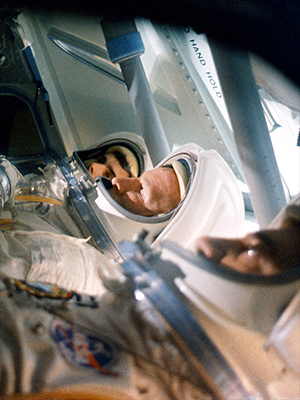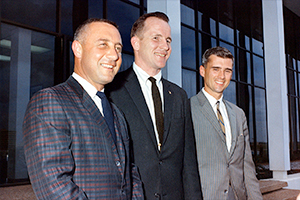September 23, 2016 — Three NASA astronauts who died in a tragic fire on the launch pad 50 years ago this January may be honored by a new monument at Arlington National Cemetery in Virginia.
Apollo 1 crew mates Virgil "Gus" Grissom, Edward White and Roger Chaffee were taking part in a pre-launch "plugs out" test on Jan. 27, 1967 when a fire broke out inside the command module. The fire engulfed the capsule, fueled by a pure-oxygen atmosphere, leading to the men's death.
Although other NASA astronauts had died in prior aircraft and automobile accidents, the Apollo 1 fire marked the first time that the U.S. space program suffered a fatal tragedy as part of its active spaceflight efforts.
The Apollo 1 Memorial Act, introduced Thursday (Sept. 22) by Congresswoman Eddie Bernice Johnson (D-TX), seeks to establish a memorial in Arlington Cemetery to honor the Apollo 1 astronauts.
"As Arlington National Cemetery is where we recognize heroes who have passed in the service of the nation, it is fitting on the 50th anniversary of the Apollo 1 accident that we acknowledge these astronauts by building a memorial in their honor," said Johnson, ranking member of the U.S. House of Representatives' Committee on Science, Space and Technology, in a statement.
Joining Johnson as co-sponsors of the bill (HR 4167) were chairman Jeff Miller (R-FL) of the Committee on Veterans Affairs; Rep. Corrine Brown (D-FL); ranking member Mark Takano (D-CA) of the Veterans Affairs committee; ranking member Donna Edwards (D-MD) of the Science, Space and Technology Committee's Subcommittee on Space and Rep. Gus Bilirakis (R-FL).
The bill directs the Secretary of the Army, in consultation with NASA's Administrator, to construct at an appropriate place in Arlington National Cemetery a memorial marker honoring Grissom, White and Chaffee.
"Though all three astronauts were posthumously awarded the Congressional Space Medal of Honor, it is surprising we do not have a memorial to honor the lives of the crew of Apollo 1, as was done for the space shuttle Challenger and Columbia crews," said Johnson.
In the wake of the Jan. 28, 1986 Challenger accident, the unidentified remains of the seven astronauts were interred near the grave for the mission's commander. According to the Arlington National Cemetery website, "it was decided by family members and NASA to construct the monument over the cremated remains."
Family members of the STS-51L astronauts and about 400 people attended the monument's dedication on March 21, 1987, including then-Vice President George H.W. Bush.
A similar monument was erected to honor the seven STS-107 crew members lost aboard the space shuttle Columbia on Feb. 1, 2003. Authorized and funded by the Columbia Orbiter Memorial Act, the monument was dedicated a year later on Feb. 2, 2004.
The Apollo 1 Memorial Act would redress the "unfortunate omission" of a monument for Grissom, White and Chaffee, according to Johnson.
The bill provides $500,000 from the U.S. Army's fiscal year 2017 operations and maintenance appropriated funds, as well as the authority for the NASA Administrator to accept donations of services, money, and property for the Apollo 1 memorial marker.
Grissom and Chaffee were buried at Arlington Cemetery. White was interred at the Military Academy at West Point in New York.
"We have the opportunity to honor these three brave men and their contribution to America's preeminence in human spaceflight," stated Johnson. "It is time to build a memorial so that current and future Americans never forget their sacrifice." |
|

Apollo 1 astronauts Gus Grissom, Ed White and Roger Chaffee are seen participating in a 1966 spacecraft design review in California. The three men died in a launch pad fire on Jan. 27, 1967. (NASA)

Apollo 1 astronauts Gus Grissom, Ed White and Roger Chaffee are seen at NASA's Manned Spacecraft Center in March 1966. (NASA)

The monuments at Arlington National Cemetery honoring the STS-51L Challenger and STS-107 Columbia crews. (NASA/Bill Ingalls) |
